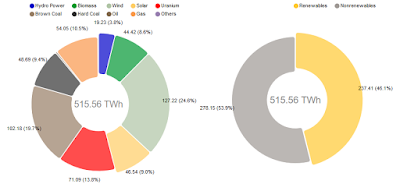Fraunhofer ISE just released the 2019 Energy charts for Germany (
LINK). In 2019, solar and wind energy plants jointly produced approx. 173 TWh. This puts them ahead of the sum of lignite and hard coal at 151 TWh.
Credit: Fraunhofer Institute for Solar Energy Systems ISE
Photovoltaic systems fed approx. 46.5 TWh into the public grid in 2019. Production increased by approx. 0.8 TWh or 1.7% compared to the previous year. The installed PV capacity at the end of October was approx. 48.6 GW. The expansion in 2019 amounted to October approx. 3.3 GW. The maximum solar capacity was approx. 33.5 GW on 19.04.2019 at 13:00. At this time, 48% of the total power generation came from photovoltaic. The maximum share of solar energy in the total daily energy of all electricity sources on 29 June was 27%. From March to September 2019, the monthly electricity production of PV systems was higher than those of coal-fired power plants.
Wind energy produced about 127 TWh in 2019 and was about 15.7% higher than in 2018, making wind energy the biggest energy source share, followed by lignite, nuclear energy, and gas. In eight months, wind power production exceeded the lignite-based generation, and in all twelve months, wind energy was ahead of nuclear energy. The maximum capacity generated was approximately 46.7 GW on 15 March 2019 at 19:00. The share of onshore wind was approx. 102.6 TWh. Offshore Wind was able to increase production from 19.1 TWh in 2018 to 24.4 TWh in 2019. Approx. 20.2 TWh were generated in the North Sea. Offshore production in the Baltic Sea amounted to approx. 4.1 TWh. At the end of October 2019, the installed capacity of onshore wind at 53.1 GW and offshore wind at 7.6 GW.
Hydropower produced approx. 19.2 TWh compared to 15.9 TWh in 2018. The installed capacity is about 4.8 GW. It has hardly changed compared to the previous year.
About 44 TWh were produced from biomass. Production has been declining slightly since 2016. In total, renewable energy sources solar, wind, hydro, and biomass in the year 2019 about 237 TWh. They are thus 7% above the level of the previous year with 221 TWh.



